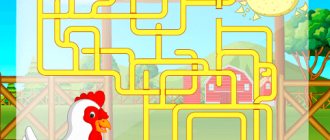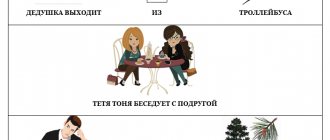Didactic material for express examination of sound pronunciation
DIDACTIC MATERIAL EXPRESS SURVEY OF SOUND PRONUNCIATION IN SENIOR PRESCHOOL CHILDREN
To enroll in a speech therapy center, the speech therapist teacher must conduct a rapid examination of the entire group. Children with FFDD are enrolled in the speech therapy center. FFNR is caused primarily by a violation of sound pronunciation. Therefore, the speech therapist must have material for prompt mass examination of children in order to identify those in need of speech therapy help.
There is a manual by the country's leading speech therapists. Konovalenko V.V. and Konovalenko S.V. "Rapid examination of sound pronunciation in children of preschool and primary school age." In my opinion, it is no different in scope from the manuals recommended for in-depth examination of children.
That's why. I developed and developed speech material for an express examination of the pronunciation of sounds for preschool children.
The structure of the express examination for each sound is as follows:
First, we check the sound pronunciation in sentences rich in a given sound. Tongue twisters and sentences of complex and simple structure are used here.
If the child pronounces correctly, you can additionally check in his own speech. To do this, ask them to come up with suggestions based on the pictures. Based on the sentences compiled, it will be possible to judge how well the grammatical categories are formed. If it turns out that there is no understanding of grammatical forms (singular and plural nouns, feminine and masculine forms, incorrect use of cases), then you can continue working on the pictures: offer to name objects in singular. and in plural including, first name feminine objects, then masculine ones, etc.
Then move on to checking another sound.
If a defect is detected, continue the examination in the pronunciation of words of different syllable structures. It is advisable for the child to name the objects (objects) in the pictures. The words are selected taking into account the sequence in accordance with the main groups/classes of the syllabic structure of words.
And as a result, the isolated pronunciation of the sound is checked, as well as in forward and backward syllables, in syllables with a confluence.
This teaching material is printed on photographic paper, placed in a folder with files for 20 pieces. I always carry it with me. Very comfortably. When examining, I simply turn the pages.
I would appreciate your feedback.
EXPRESS EXAMINATION OF THE STATE OF SOUND PRONUNCIATION IN CHILDREN 5 -7 years old
(Whistling sounds. Sounds S - S)
1.Repeat:
Little Sanya's sleigh moves on its own. There is a tall pine tree in the forest.
Little Sanya drives the sleigh on its own. Sonya bought juice.
2. Name and repeat: Beads - dog - soup - forest - sock - scooter - table - masks - shepherd - bench
3. Repeat: S-S-S-S-S sa – so – su – sy; as – os – us – ys;
ska - sko - hundred - stu - sleep - dreams - spa - sleep;
4. Repeat:
Senya is carrying hay in the canopy
,
Don't be afraid - it's a goose, Plums are hanging on a branch.
Senya will sleep on the hay. I'm afraid of him myself. Vasya is herding geese.
5. Name - repeat: Sieve - fox cubs - seven - goose - autumn - cornflower - snow - plums - traffic light
6. Repeat:
sya – syo – syu – si; as - axis - us;
slya - sli - laugh - stya - shame - sti - sleeping - sleep - sleep - all - all - all;
EXPRESS EXAMINATION OF THE STATE OF SOUND PRONUNCIATION IN CHILDREN 5 -7 years old
(Whistling sounds. Sounds З - Зь)
1. Repeat:
Zoya is the bunny's mistress, Zoya has a mimosa. Zoya puts a mimosa in a vase.
The bunny is sleeping in Zoya's basin.
2. Name - repeat: Goat - alphabet - tooth - cart - fence - name - umbrella - nest - Dunno
3. Repeat: Z-Z-Z-Z for - zo - zu - zy; az – oz – uz – yz; zva – zvo – zda – zdo – zna – zna;
4. Name it - repeat: My little goat has green eyes. A goat gnaws on green cabbage.
In winter, Zina's nose gets cold. Kuzya goes to the museum.
5. Name - repeat: Winter - newspaper - goat - shop - snake - grain - monkey - strawberry
3. Repeat: zy - ze - zy - zi; azi – oz – uz – iz;
zve – zvi – zve; I know - I know - I know - I know; serpent - serpent;
EXPRESS EXAMINATION OF THE STATE OF SOUND PRONUNCIATION IN CHILDREN 5 -7 years old
(Whistling sounds. Sound Ts)
1.Repeat: From the neighboring well Chicken and hen The hare sits under an acacia bush.
Water flows all day long. They drink water on the street. There is water in the well.
2. Name - repeat: Face - chicken - chain - hare - well - saucer - flower - towel
3. Repeat: Ts-Ts-Ts-Ts-Ts ats - ots - uts - ets - its; tsa - tso - tsy - tse; tsva - tsve - tsvi;
EXPRESS EXAMINATION OF THE STATE OF SOUND PRONUNCIATION IN CHILDREN 5 -7 years old
(Hissing sounds. Sh sound)
1.Repeat: Hush, mice, don’t make noise, Masha sewed for the monkey, Dasha washes her neck and ears in the shower.
Don't wake our cat. A fur coat, a hat and pants. The mouse has a hat.
2. Name - repeat: Porridge - reeds - jester - shower - bag - cockerel - closet - cherry - grandmother - sunshine
3. Repeat: Sh-Sh-Sh-Sh-Sh sha - sho - shu - shi - she; ash - osh - ush - ish - ysh; shka - shko - shku
(Hissing sounds. Sound F)
4. Repeat: The beetle has fallen and cannot fly. Without sparing its legs, the hedgehog runs.
He is waiting for someone to help him. The hedgehog has a hedgehog.
5. Name - repeat: Skis - greedy - beetle - hedgehog - pie - spoon - scissors - skier - snowdrop
6. repeat: Zh-Zh-Zh-Zzha - zho - zhu - zhi - zhe; waiting - waiting - waiting; zhna - zhno - zhnu - zhzhny;
(Hissing sounds. Sound Ch)
7. Repeat: Water, water, wash my face. Tanya is swinging on a swing. The girl bakes cookies.
8. Name - repeat: Clock - swing - tea - ball - rich man - candle - barrel - cookies - Snow Maiden
9. Repeat: Ch-Ch-Ch-Ch-Ch ach - och - uch - ich; cha - che - chu - chi;
chnya - chne - chnyu - chni; honor - honor - honor;
(Hissing sounds. Shch sound)
10. Repeat: I drag the pike, I drag it, The puppy squeaks in the gorge. Children are looking for a puppy.
I won't miss the pike.
11. Name - repeat: Pike - shield - cape - puppy - pliers - brush - click - glazier - traffic controller
12. Repeat: sch-sch-sch-sch - sch sch - sch - sch - sch; sha - schu - schu - cabbage soup;
schnya - schnyu - schni; vscha – vschu – vschi;
EXPRESS EXAMINATION OF THE STATE OF SOUND PRONUNCIATION IN CHILDREN 5 -7 years old
(Sonoras: Р – Рь)
1.Repeat: A mole climbed into our yard, Vera and Roma are drumming on a drum.
Digging the ground at the gate. There are carps in the pond.
2. Name - repeat: Feather - cow - cancer - ball - ram - tomato - pipe - watermelon - tram - grapes
3. Repeat: R-R-R-R-R ra - ro - ru - ry; ar - or - ur - yr; tra - tro - tru - tra; sconce - bro - bru;
4. Repeat: At my sister Marina’s, Rita and Varya are making jam.
Cheeks like tangerines. Marina is cooking rice.
5. Name - repeat: Turnip - rowan - lantern - cucumber - mushrooms - tourist - backpack - mittens - apricots
6. Repeat: rya - re - ryu - ri; ar - or - ur - yr; quack - cre - cru - cree; three - three - three;
(Sonoras: L - L)
7. Repeat: A young elk ran through golden straw. Mila was washing the floor in the classroom. Alla was eating an apple.
8. Name - repeat: Soap - milk - onion - pencil case - table - wolf - squirrel - lightning - flower bed - needle
9. Repeat: L-L-L-L-L al - ol - ul - yl; la - lo - lu - ly;
kla - klo - klu - slu - slo - sly - plo - ply - gla - glo - glu;
10. Repeat: They stomped and stomped, they stomped until they reached the poplar, Luda watered the tulips from a watering can.
They stomped all the way to the poplar, but their feet stomped. Lena has a green ribbon.
11. Name - repeat: Log - lion - lemon - vacuum cleaner - watering can - frog - snail - refrigerator
12. Repeat: la - le - lyu - li; al - ol - ul - il; for - for - for - for; vlya - slyo - angry - pli;
Speech therapy diagnostics of preschool children
Speech therapy diagnostics consists of the following:
- Filling out the medical history card by the teacher and parents;
- Examination of the child’s fine, general and articulatory motor skills;
- Studying the volume of vocabulary (passive - understood, and active - pronounced) of the baby;
- Checking the state of grammatical structure, phonemic processes (perception, analysis and synthesis of sounds) and coherent speech.
Akimenko speech examination technique
In modern kindergartens, V. M. Akimenko’s technique is used for speech therapy examination of children with speech disorders. This is an automatic computer program that conducts testing and processes the received data. Diagnostics is carried out in 15 main sections, includes tasks for children, detailed instructions and methodological materials for a speech therapist.
Additional Information! After testing, the program allows you to make a speech therapy conclusion, make an accurate diagnosis of a speech disorder and outline the process of correctional work.
Study of the state of phonemic perception
The state of phonemic awareness is tested by playing "Parrot". The baby is given the task of repeating two sounds: ka - ga; pa - ba; ba - on. Then a complication occurs - you need to repeat not the sounds, but the words: bowl - bear, varnish - cancer.
Checking compliance with the pattern and sound-syllable structure of the word
Compliance with the pattern is the order of reproduction of syllables in a word. A preschooler can “cut off” difficult-to-pronounce sounds in his speech (ka - mouse), or rearrange them (barelina - ballerina). When examining five-year-old preschoolers, you can use words consisting of 3-4 syllables, as well as materials with a combination of consonants.
Study of pronunciation and speech production
The study of pronunciation and speech production includes:
- study of the articulatory apparatus and articulatory motor skills;
- state of sound pronunciation;
- reproduction of individual sounds and words, as well as coherent speech.
In the methodology for examining the articulatory apparatus, special attention is paid to the organs of articulation: tongue (long, short); teeth; soft palate (gothic, high, normal); lips (normal, cleft lip, thin, thick). Articulatory motor skills play an important role in pronunciation. Basic exercises: tongue with a spatula and a needle, puff out your cheeks, smile and make a straw with your lips.
Complex of articulation gymnastics for children 4-5 years old in the middle group
Speech therapy diagnostics carried out for children 3-4 years old include a large number of exercises performed by imitation - the speech therapist shows them and then performs them together with the child. In older preschool age, preschoolers perform tasks from memory and only practice new exercises with an imitation teacher (however, they should not be included in the speech therapy examination).
Additional Information! The state of pronunciation and speech reproduction is checked using pictures using the task method: “Show me where...”. There should be a lot of picture material for every sound and syllable.





